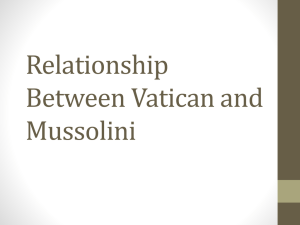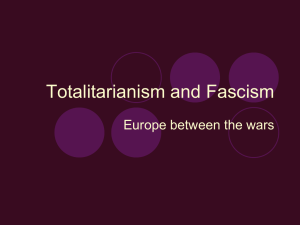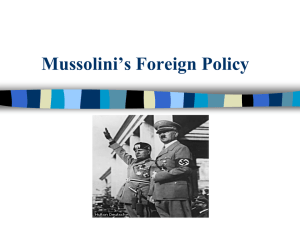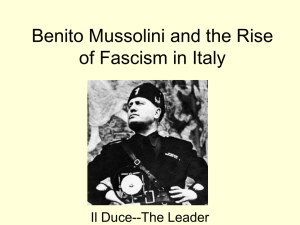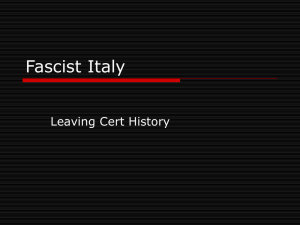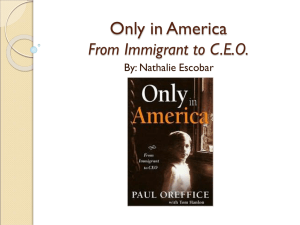Italy (1919-1939) - MrWilsonsUSHistoryWiki
advertisement
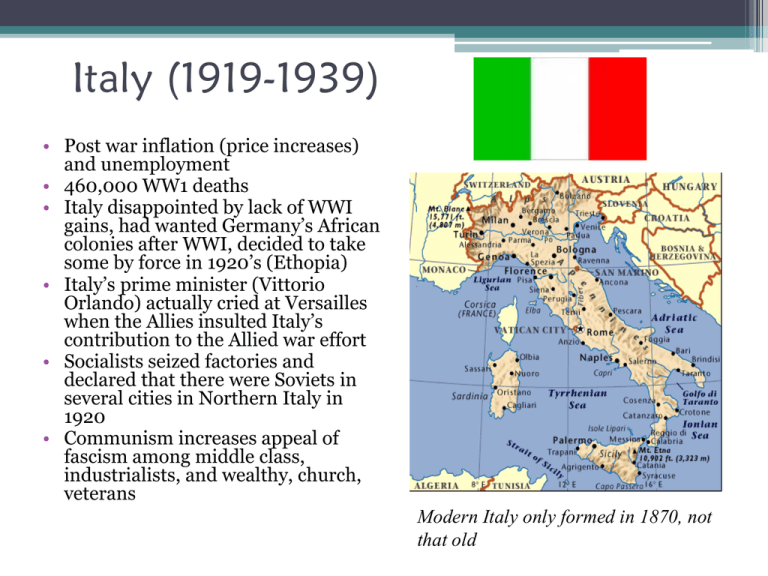
Italy (1919-1939) • Post war inflation (price increases) and unemployment • 460,000 WW1 deaths • Italy disappointed by lack of WWI gains, had wanted Germany’s African colonies after WWI, decided to take some by force in 1920’s (Ethopia) • Italy’s prime minister (Vittorio Orlando) actually cried at Versailles when the Allies insulted Italy’s contribution to the Allied war effort • Socialists seized factories and declared that there were Soviets in several cities in Northern Italy in 1920 • Communism increases appeal of fascism among middle class, industrialists, and wealthy, church, veterans Modern Italy only formed in 1870, not that old Fascist Party • Born March 23, 1919 in Milan • Symbol of the party is the fasces, a bundle of sticks, symbolizes that society is individually weak, but collectively strong • Fasces are also an ancient Roman symbol of authority. They are rods and axes wrapped into a bundle • The rods were used for punishment, and the axes for execution. • The ideal of fascism is that the different social classes will work together for the good of the country • Benito Mussolini, leader of Fascists Eagle with fasces used on the war flag of the Repubblica Sociale Italiana (civil flag is the same of the present day Italian Republic, but was never used) Mussolini • Former socialist, but had favored WW1, because he saw it as a way to gain territory • Used to be a propagandist for a socialist newspaper • Fought in WWI until wounded by an exploding mortar in his trench, only advanced to rank of corporal • Editor for fascist party paper “Il Popolo d’Italia (The People of Italy)” • Fasci di Combattimenti (Italian Combat Squad) (aka the Black Shirts), party street army, beat up opponents in streets, made people drink castor oil (communists, anarchists, strikers, etc.) Mussolini as a soldier 1917 Insignia for the shoulder of the rank of corporal of the Italian Popolo d’ Italia Army Mussolini and his Black Shirts Painting of Mussolini’s Black Shirts March on Rome (October 28, 1922) • Black Shirts marched on Rome • Mussolini waited in Milan to see if the overthrow succeeded, and then joined and pretended to have led it • King lets Black Shirts enter Rome without a fight, King Victor Emmanuel III wanted to use Mussolini to destroy communists, then planned to get rid of Mussolini Black Shirts- March on Rome March on Rome Duce et decorum: Benito Mussolini and four of his Generals, March on Rome King Victor Emmanuel III and Mussolini the dictator March on Rome and Commemorative March on Rome Medal • October 29, 1922 declared day one of year one of the new fascist era (Mussolini made dictator for a year) • Mussolini became Prime Minister, later “Il Duce” (The leader), comes from Roman title dux (leader) • Fascists guaranteed 2/3 majority in legislature in 1923, by Acerbo Law • Party won big in elections of 1924, given decree power • Other parties kicked out of legislature, Socialist leaders beaten to death by Black Shirts Mussolini’s flag Il Duce Mussolini before the masses in Rome (using the Fascist salute) Fascist Italy flag Press controlled in 1923 • Journalists need license from Fascist party to write • Mussolini’s paper Il Popolo d’Italia (The People of Italy) • In 1929, Mussolini raped a reporter for the London Herald after she gave him a bad interview • Radio controlled • Theater controlled • Film scripts approved, film studio opened, pro-fascist films given 100% government funding, government bought chain of theaters, controlled foreign films, foreign films dubbed, exported films not dubbed • In 1930, it was forbidden to distribute any Communist or Marxist literature, though technically not illegal for libraries to possess it for scholarly work (research) • In 1938, all books relating to Communism, freemasonry, or Jewish culture were ordered destroyed, though many librarians merely hid the books Censorship of Private Communications • • • • • • • • Telephone calls and letters were monitored Calls were often listened to and sometimes interrupted Mail was opened and read Private communications of people walking down the street were monitored by secret police Italians commonly walked around in silence In 1924, the Mafia hounded after Mussolini offended the Mafia boss in Sicily, boss emptied town of inhabitants except for 20 beggars when Mussolini was supposed to speak to the “assembled populace” Freemasonry and other secret societies suppressed in 1925 By 1926, political opposition was outlawed Anarchist Anteo Zamboni • On October 31, 1926, 15-year-old Anarchist Anteo Zamboni tried to assassinate Mussolini; he was caught in the act and lynched on the spot Other techniques used for building Fascist support and eliminating enemies • Secret police organized in 1927- (OVRA) Organization for Vigilance and Repression of Anti-Fascism • Tribunale Speciale (Special Tribunals) courts established to try “political crimes” • Political offenders sent to prison on remote Lipari and Ponza Islands or other camps • Citizens encouraged to tell on neighbors • Death penalty re-introduced, only used 10 times before 1940 • By 1928, all elections were yes/no votes on candidates chosen by party • In 1931, all university professors had to take an oath to defend fascism • Report cards and required notebooks have fascist symbols, phrases, and pictures of Mussolini • Textbooks rewritten, overstate Italian war victories Mussolini Propaganda • Shaved his head to appear younger and more masculine and powerful • American razors were not good enough for Il Duce’s manly beard • Pictures of him flying an airplane, driving a race car, winning a chess match, playing the violin, jogging; many of these were faked • “The Duce is always right”, “Believe, Obey, Fight.” • “The book and the musket make the perfect fascist.” • “Long live death” “War is to man as motherhood is to woman.” • Became popular with all classes in Italy • Formula 1 racing big for prestige, Germany (Mercedes-Benz, Auto Union), Spain, France, Italy (Ferrari, Alfa Romeo, Maserati, Bugatti), GB (ERA) • Stamps, architecture and sculpture used to remind people of ancient Roman glory • Foreign words forbidden in 1936, by the Ministry of Popular Culture, Louis Armstrong becomes Luigi Fortebraccio, Jazz eventually banned • Increase the birth rate (Battle for Births) • Each family was to try to have at least 5 children • Bachelors taxed at more than twice the normal rate • “He who is not a father is not a man.” • Abortion illegal, contraceptives discouraged • Women discouraged from working, riding horses or wearing trousers • Mother and Son Day created and celebrated Youth Organizations • By1926, they created paramilitary organizations (The Opera National Balilla, ONB), membership was voluntary but coerced • Mussolini actually met in England with Robert Baden Powell, the founder of the Boy Scouts, for advice • Balilla Motto: "I believe in Rome, the Eternal, the mother of my country……I believe in the genius of Mussolini…and in the resurrection of the Empire." • “Sons of the She Wolf” (ages 6-8) • Girls not added until 1929Piccole Italiane (Little Italian Girls) (ages 814) Giovani Italiane (Young Italian Women) (ages 14-18) (Girls learned childcare, first aid, physical exercise, political indoctrination) The Opera National Balilla (Fascist Youth), a failed attempt at youth Fascist paramilitary instruction Robert Baden Powell and the Boy Scouts logo Sons of the She Wolf Balilla ages (8-14) Fascisti Universitari age up to 21 Avanguardista (Vanguard) (ages 14-18) Girls not originally part, added 1929 with the Fascio Femminile • Employees got unemployment and health insurance, but weren’t allowed to strike • Constructed motorways (Autostrada), the first in world history • New public buildings, used style of Gruppo 7, architects starting in 1926 • Tried to build new model agricultural town, Mussolinia, in southern Italy to build prosperity there (Battle of the Southern Problem), never completed • Drained Pontine Marshes near Rome to create agricultural land (Battle for Land) • Rearmament helped spur employment • Hydroelectric power programs were undertaken • Public begging ended Labor and Make Work Programs Autostrada Highway signs Fred Toelle, “P.O.W.’s draining in the Pontine Marshes Raised barge of Roman emperor Caligula from bottom of Lake Nemi Drawing of Caligula’s boat Catilgula’s Boat The Fascist Economic system: • Government controlled industry, although private ownership was allowed to continue • The economy was set up for the military and war • Mussolini sought economic self-sufficiency (Battle of Grain is an example – Mussolini tried to increase grain production, at cost of fruit production, increased tariff on foreign grain, failed) Economy: •Il Duce needs gold- almost half million women turn in wedding rings for steel replicas •Balanced budget •Ended inflation •Buy Italian campaign started in 1936 •Battle of the Lira, Mussolini tried to raise the value of Italian currency • Mussolini felt it looked bad for Italy to have such a low valued currency •Mussolini artificially raised the value of the Lira, which made prices of Italian exports rise, and thus fewer to be sold (This raised unemployment in Italy.) (BAD) Italian Lira •Mussolini could not overcome his nation’s lack of industry, Italy could not become an economic power as quickly as he hoped •Gold for the Fatherland Program: was a program that asked people to donate wedding rings and gold jewelry which was melted down, cast into bars, and distributed to Italy’s banks, people were given iron arm bands with words “Gold for the Fatherland” on them Labor Religious Tolerance and Intolerance • Labor and management combined into corporations, workers cannot Lateran Agreements : (February 11, 1929) strike or lockout •Annexed Papal States (Pope’s country) • Workers rewarded with free and left the Vatican (1 square mile) Sundays, cheap vacations, paid holidays, social security, sports • Rewarded the Pope by guaranteeing and theater facilities Catholicism in Italy • Italian railroads ran on time for first time in Italian history (or someone died). Mussolini was tired of other countries making fun of the relaxed Italian sense of time. • It was also thought the railroads running on time would help job opportunities. Benito Mussolini reads his credentials prior to signing the Lateran Treaty on behalf of King Victor Emmanuel III. Cardinal Gasparri (seated), signed on behalf of Pope Pius XI. (Left) Mussolini signs the Lateran Pact of 1929, which brought into being the Vatican City State. (Middle) Cardinal Gasparri signs the Lateran Concordat as Mussolini looks on. (Right) Vatican flag Seals and signatures; Benito Mussolini and Cardinal Gasparri Postcard commemorating the Lateran Pact Pope Pius XI Religion Continued: Cardinal Gasparri and Benito Mussolini (seated) after exchanging treaty ratifications in the Hall of Congregations, the Vatican, and June 7th, 1929 •Government pays salaries of priests, teach Catholicism in schools •Jehovah’s Witnesses persecuted because of opposition to warfare and totalitarian government •Mussolini adopted anti-Semitism after 1937, after meeting with Hitler •Mussolini had to break up a romance between his daughter and a Jewish boy Mussolini At the same time Mussolini was tolerant of Islam in the Italian colony of Libya and was named “Protector of Islam” there.


